
10 minute read
According to market research firm Global Industry Analysts, the e-learning industry is expected to more than double from $107B market size in 2019 to more than $350B by 2025. And this estimate was before 2020, when the global pandemic. With more and more people working from home, more and more are also learning from home. Industry experts now anticipate the industry to surpass $500B by 2025!
So it’s no surprise that we’ve seen an influx of new online instructors eager to capture their slice of this fast growing pie. But though opportunities abound, there are many misconceptions and myths that is keeping so many from entering this lucrative and still, quite nascent, industry. As online instructors who first entered the space in late 2014 and have since coached and advised 100’s of new instructors since, we want to help dispel some of these myths today.
A few years ago, we counted ourselves among the lucky few who achieve six figure incomes from online courses. Fast forward to today and there are literally 1000’s more new six figure instructors minted each year. And get this, online instructors don’t do it the same way—we all reach this milestone through our own paths within e-learning.
There are multiple ways for each online instructor to achieve $100K+/yr in earnings. The key is finding which one is the right one for you.

In fact, we (Evan and Symon) are a perfect example of how we both achieved our goals in very different ways with online courses. We know because we took very different approaches eLearning. Interestingly, we inadvertently proved this out by taking different approaches to teaching the same course topic.
Evan’s first course was actually on Airbnb hosting—he was subletting his expensive San Francisco apartment on Airbnb during the busy summer months to pay for his rent for the rest of the year while he vacationed in Asia!

But there just wasn’t a big enough audience on Udemy for an Airbnb course. And there wasn’t room for Evan to make multiple courses on the topic. So he pivoted and tested out other course ideas until he found a category that clicked for him and his audience: entrepreneurship. Today Evan’s one of the most popular instructors on Udemy and he has expanded his coverage into other topic areas.
Evan took a concentrated approach by only focusing on one platform: Udemy. He started with Airbnb but then kept pivoting until he found the right fit. He quickly went from zero to dozens of courses within a few years’ time, with all of the courses related to entrepreneurship. This meant that students who signed up for one of his courses are likely to sign up for some of his many other courses. He found his platform first, then he found the right topics to fit the platform and its audience given what he’s interested in teaching.
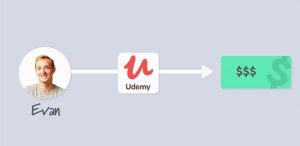
I (Symon) also ended up (and still) teach a course on Airbnb hosting. But my e-learning journey is much more of a shotgun approach than Evan’s. While I also taught on Udemy, I did not focus on it to the same degree as Evan did. Instead, I leveraged my online course content into alternative income streams through consulting, book deals, audio courses, and joint venture deals that all ran off platforms like Udemy. Unlike Evan, I picked my topics first, and then found the right strategy for them afterwards.
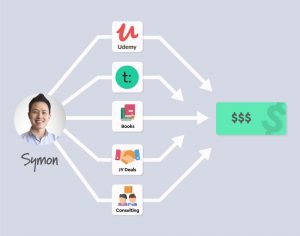
For my real estate investing audience, I chose Udemy because there is a big enough audience to make low sale prices work. More potential students mean I could sell at a lower price point to each student. For Airbnb, the audience is much smaller and targeted, so I took a indie route with its own website and marketing channel.
Fewer potential students meant I needed to sell at a higher price point because there just aren’t as many people who are into Airbnb hosting as there are people who want to learn real estate investing.
We took very different approaches but we both still achieved our goals of generating multi-six figure income streams from online courses. Some instructors succeed like Evan. Some more like me. And many others, in ways entirely different from what we both did. The key is choosing the right strategy for your topic, your audience, and your own preferences.
Of course, we would want to teach courses that generate income for us. The bigger the better. But there are other important factors to consider besides just the dollars. The top programming courses online generate over $3M/year on Udemy.
Should every new instructor try to make a programming course? Of course not. You still have to teach something you can and want to teach. If you know nothing about a topic or you aren’t able to become proficient enough to teach it, it’s not going to work. While you don’t need to be a PhD with 30 years of experience, you need to know more than your intended target audience. You also need to know it well enough to be able to articulate yourself and structure a coherent curriculum for your students.
Okay, let me ask you a question: Would you rather earn $5K/mo or $1K/mo?

Easy right? Of course $5K/mo! But what if to earn that $5K/mo, you have to work 40 hours a week? And to earn the $1K/mo, you have to work 1 hours a week?
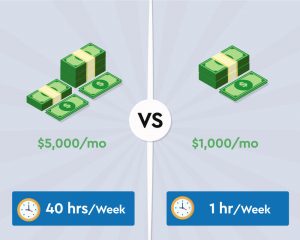
Which option would you rather have now? If you’re now feeling more affection towards that $1K/mo option, you’ve got good intuition. If you still chose the $5K/mo option, let’s look at the math.
$5K/mo at 40/hrs per week means $5K over 160 hrs per month. That’s $31.25 equivalent hourly wage. Not bad. That’s $62.5K annual salary rate.
How about the $1K/mo option at 1 hours a week? That’s $250 equivalent hourly wage! Or the same hourly rate as someone with a $500K annual salary.
But it’s still $5K to $1K? Isn’t it? Yes, it is. But how about the hours?
If you worked 40 hours a week, you’re maxed out. You could only do ONE $5K/mo gig if that gig took up your 40 hours available for working. But at 1 hour a week, you could add 39 more of the same gigs! That’s the power of online courses.
IF you choose carefully and create courses that generate income without taking up all of your time.
The $5K/mo option caps you out at $5K/mo because your hours are maxed out. You don’t have more time available. But the $1K/mo option takes up so little time, that you have all the time to create more of similar income streams. So what does this have to do with online courses? Imagine filling up your 40 hour week with 40 courses that generate $1K/mo. Now for 40 hours a week of work, you could generate $40K/mo.
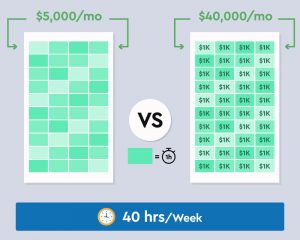
Don’t just pick topics with a big income potential. You have to look at the incremental time requirements for maintaining the course.
Some courses topics as well as strategies require much more time input than others. It doesn’t rule them out but it’s something to keep in mind. For example, programming courses get lots of hard student questions but they also generate a lot of income. So the time may be worth it for those instructors who do well in these categories.
Some independent courses take up much more time than courses being sold on marketplaces like Udemy, but they can also generate much bigger income to offset the extra time requirements. The key is not to look at one without the other—look at BOTH your earning potential AND the time it takes to maintain those earnings.
So what is possible in terms of return on your time with online courses? $1000+/hr is not only doable, it’s quite common. Because there are many courses that require almost zero maintenance time.
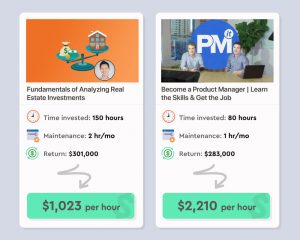
My main course on Udemy (real estate investing course) takes me about a hour a week to maintain but generates about $5K/mo for me, yes, that is over $1,000/hr return on my time. Evan’s top course does him even better, helping him achieve over $2200/hr return on his time given the minimal maintenance required.
“It’s too late to start making online courses.”
“There is too much competition already.”
“Someone else is already teaching what I want to teach.”
These are the same reactions that most people have when they first start looking into online courses. These were the same thoughts that we had when most of us got started way back in 2016. We were totally wrong then and I’ll show you why these are still wrong today. Let’s go back to 2016 first.

Evan got into teaching business and entrepreneurship courses. There were dozens of courses in the space already, some even taught be well known figures like Seth Godin. When I (Symon) got started, I taught real estate investing. There were literally 100’s of courses online already in the topics we chose, many also with well know figures in the space. Neither of us were known names in our chosen topics, so who were we to enter into the space to compete?
When we both entered e-learning, our chosen topics were crowded with established instructors. Many around us thought it was too late to enter, including ourselves. But we were wrong then and that sentiment is still wrong today. Because there are two truths about online courses that we’ve discovered over the last six years in the space.
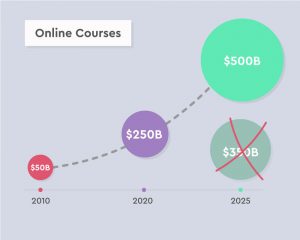
TRUTH: The online course pie is growing at a breakneck pace.
The entire industry was $50B in size in 2010. It was on pace to grow to $350B by 2025 before the pandemic. It is now expected to grow to $500B by 2025 due to recent boost to remote learning. That is a 10X growth in 10 years!
This means that the demand is FAR outpacing the growth in supply–there aren’t enough instructors making courses to keep up with demand. It also means that the overall pie and the pies for just about every single subject is growing. And that leads us to the second truth in online courses: You can always find your slice of the pie. Why? Because students aren’t homogenous. They have different preferences and learning styles.

TRUTH: There will always be a subset of students who would prefer to learn from YOU over anyone else.
They would prefer your style, your curriculum, your voice, even your face! (On the flip side, there will always be a subset of people who will absolutely hate everything about you! But you need not worry about them because it’s only your fans that matter). No matter how crowded the space, there’s always room for a new instructor to claim their slice of the pie.
Of course, the standards are higher today than they were before. But that’s a good thing. Most instructors, especially the new ones are slow to adopt the new standards. So the few who do meet or exceed the new standards will stand out from the crowd from the get go.
You do need to think carefully about and plan your curriculum. You do need to elevate your production standards and use property equipment. Gone are the days when you can get away with no planning and use a cheap webcam with awful mics creating poorly executed content. But not all categories are saturated with 100s of competitors. In fact, you would be early in many topics that are growing rapidly today but were not very interesting only a year or two ago.
For example, soap making, bread making, and even high school math. These were all topics that generated very modest earnings previously but now the top instructors are earning high five to mid six figures teaching in these topics. To find out some the new exciting opportunities are, check out our Opportunities page here. We are still early and there is still so much growth to come. Will you be on the sidelines or will you ride the growth with us?
One of the surprising things we get from folks who learn about online courses and are convinced of its potential but still decide to wait on the sidelines, is that they seem to think it requires a near full time commitment to make a course.
Sure, the more time you have to commit to it, the better and the faster you can release your course and start earning. But to get started, it takes a lot less time than you might think. How much time? Well, let’s start off by defining how much content is typically in a good course.
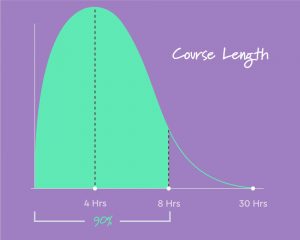
Depending on the topic and your competition, a good course with a thorough curriculum could range anywhere from 5 hours all the way to 50 hours long. Although most are under 10 hours. And from our experience, having published nearly 50 courses of our own and having coached dozens others in making many more courses of theirs, it takes on average 10 to 20 hours of work for every hour of content in the course.
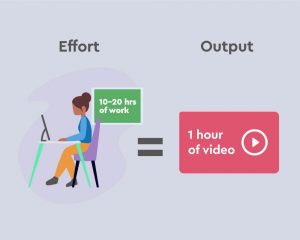
So a 5 hour long course will typically take 50 to 100 hours to produce.
Why the wide range?
How long it takes you to make a course depends on a number of factors, from how well you know your topic to how comfortable you are with the whole production process. If you don’t know your topic quite as well and you need to spend more time researching and learning the topic yourself, it’s going to take longer. If you’ve never made a course, recorded yourself, written a curriculum, etc…it will take you longer.
Starting out, most first time instructors will fall closer to the 20 hour of work per hour of finished content. But as they get better and create more courses, that number drops rather quickly towards 10 hours of work per hour of finished content. So let’s look at an 6 hour long course for example. An experienced instructor may take only 60 hours to create it.
Working part time a couple hours a night on week days and one day on the weekend, the experienced instructor can finished the course in 3 to 4 weeks. For a new and inexperienced instructor, a 6 hour course will take closer to 120 hours. If the instructor sets aside just 10 hours a week–only one hour a day on week days and half a day on the weekends, they will finish the course in 3 months. If they can only put in 5 hours a week, it will take closer to 6 months.
But would that be worth to you? If spending 120 hours, even if spread out over 6 months, could give you a course that helps you earn passive income of $1000 per month or even $5000 per month, month after month, for years? I spent closer to 200 hours spread over 8 months when making my 1st course but it still generates $5000 to $6500 per month in passive income over 6 years later, with minimal input from me to maintain it.
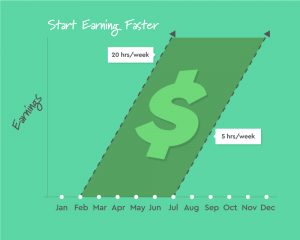
This has been nothing short of life changing. The freedom allowed me to quit my day job, make more courses, grow my income and get the freedom and flexibility I’ve always dreamed of. If you can set aside 5 hours a week, you can create a solid online course that generates recurring passive income for you. But it helps to avoid the common mistakes new instructors tend to make.
Learning from our mistakes in life is important. The same applies with online courses. In the early days, Evan and I both made just about every mistake that online instructors could make. From using the wrong gear to using poor editing techniques to using inefficient processes that wasted hours of time. So should new instructors today do the same? No!
They should learn from our mistakes. Why go through the trial and error of wasting 1000s of dollars and months of effort when you don’t have to? With the consistent growth we’ve seen in the space and the steady rise in instructors, the competition has gotten stiffer. But it also means the best practices are a lot more obvious.
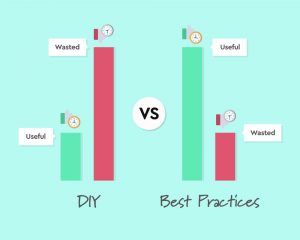
There are clear winners in every single topic and on every single platform. Just by looking at the winners and comparing them to everyone else, it’s easy to determine the following:
You get to see in plain sight what works and what doesn’t work. What you should emulate and what you should avoid.
And for our students in our Six Figure Instructor Fast Track Program, we did all of that work for them. They didn’t have to do their own research on gear, software, techniques, and best practices. We tell them what works and doesn’t work because we’ve all the work. We also give them all the tools and templates to short cut their way to the best results.
You don’t have to go through a long and costly process of trying to figure everything out yourself. You can avoid all the beginner mistakes and get straight to what works from day one. If you’re seriously considering entering the space and want to know if online courses might be a good fit for you to generate income or to grow your business, check out our program.
Subscribe now for free tools, strategies and resources